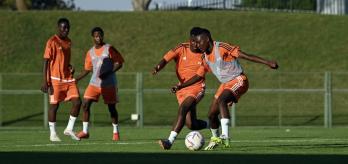We all know we need to concentrate to solve specific problems, and professional footballers are no different in this respect. For instance, whether it’s a defence-splitting pass or playing out against a high press, this ultimately means focusing your attention (and your eyes) on the job in hand. In this session, Prof Daniel Memmert explains what's going on in our brains when we focus on a specific task, and considers how coaches can use the latest scientific insights to potentially help players think on their feet during games. The session is followed by a Q&A, hosted by FIFA's Dr Paul Bradley.
Introduce the concept of visual attention and the link between attention and decision-making. Show how attention can be measured in a laboratory. Suggest how coaches could tailor their training regimes to maximise players' available attention span/working memory.
As humans, our attention is limited by a number of factors, and we can be distracted by various environmental and cognitive influences. Overloading our attention/working memory can lead to mistakes and impaired performance.
Coaches should be aware that there is a limit to the number of instructions players can absorb and implement, and be wary of issuing too many instructions. The instructions they do provide should help players to solve specific problems on the pitch.
Watch presentation
Read summary
Part 1: Attention and decision-making
In the opening section of his presentation, Prof Memmert explains what we mean by attention in a scientific context and explores the link between attention and decision-making. Before we can solve a problem, we have to focus our attention on it, and that requires a cognitive process that is a lot more complex than it appears. To highlight this complexity, Memmert talks his audience through what he calls the "sub-processes" of attention, illustrating each one with an example from the football pitch.
Part 2: Measuring attention in the lab
In the next part of the session, Prof Memmert uses a number of lab-based studies from the world of sport and beyond (including the famous "invisible gorilla" experiment) to show how environmental factors and cognitive variables can affect attention and cause us to overlook significant details. The findings provide significant insights as to how the instructions given to players can affect the breadth and depth of their attention – and, by extension, their performance, too.
Part 3: Using the attention window on the training pitch
In the final part of his presentation, Prof Memmert turns his attention to what this means for practitioners. As he points out, all human beings operate within a limited "attention window," the framework that defines what we can perceive at any given moment. To conclude his presentation, Memmert explains how this window works, and suggests how coaches can use the concept of the attention window to help them get their messages through to players.
Q&A
00:54
The first question is a basic one: is attention general, or is it a domain-specific quality?
02:24
Is attention position-specific?
04:44
What about the factors that influence attention? Do stress and anxiety affect attention in players?
06:18
We know that football is very tactical. How can you train attention to foster things like tactical intelligence?
11:12
Could you train cognition and cognitive skills online?
15:55
How can we best educate coaches in this area?
17:33
Virtual reality (VR) is part of the game now. Can we use VR in this area, or do we really need to do everything on grass?
20:30
If you could give a practitioner some take-home points on attention in football, what would they be?

















